
Winston Schaumloffel ’25 demonstrates one of the many pieces students have created using the suite of 3D printers and other production technologies that are available for the community’s use in ITS MakerSpace.
“Here, you are welcome to tinker—try things out, break things apart, see how they work, adjust them a bit—and try again. That’s how learning happens and ideas come to life.” This is how John Mangicaro, instructional technology engineer and manager, explains the guiding principle behind Syracuse University’s ITS MakerSpace—a fabrication lab and creative workshop that is open to all members of the University community.

Student staff at MakerSpace help members of the University community problem solve and use the wide range of equipment.
MakerSpace hosts dozens of 3D printers of different capacities, including the most modern models and some of the largest in New York state; two laser engravers, embroidery and sewing machines; equipment for printing on vinyl, fabric and other materials; and a recording studio. It’s a lively and inviting space with the evidence of flourishing creativity all around: bright sculptural bits from 3D printers, pieces of engraved wood and glass, clothing, mugs and stickers with designs in various stages of testing, and sketches and diagrams scattered across tables. The art on the walls dates back to when the space was the University’s legendary Jabberwocky Club—a student-run music venue in the 1970s and ’80s—and there’s a constant hum and whirr of machines in action and conversation among those working on projects.
Welcoming Curiosity and Experimentation
It’s the spirit of experimentation and curiosity, as much as the technological resources, that has made MakerSpace such a valuable support to a range of academic, creative and entrepreneurial endeavors.
“We honestly could not have made this without MakerSpace,” says Elan Fullmer ’24, as he demonstrates the functionality of a propeller that he and his teammates designed for their mechanical engineering capstone project. As one of the 19 industry-sponsored projects the engineering capstone students engaged in this semester, Fullmer and his teammates have been working to optimize small-scale wind turbines for local power generation. In MakerSpace, his team created different versions of their design, ultimately producing their prototype on the largest 3D printer, which allowed them to create key elements as single pieces.

Engineering students Sydney Jud ’24 (left), Elan Fullmer ’24 (middle) and Kendra Miller ’24 used MakerSpace printers to create a prototype wind-energy propeller as part of their industry-sponsored capstone project.
As Alexander Deyhim, their professor in the College of Engineering and Computer Science, puts it, MakerSpace enables students to engage in the process of invention. “We’re preparing our students for the real world—to be the ones who imagine and create solutions to real world problems.” At MakerSpace, students have a chance to see the potential of their ideas, he says. “They have an idea, they design it, they get hands-on practical feedback from John and the staff—and by the end of the day they have a prototype in their hand. This lets them communicate their ideas, have better discussions and fine tune the process,” he explains. “That’s a huge step in innovation.”
We’re preparing our students for the real world—to be the ones who imagine and create solutions to real world problems.
Professor Alexander Deyhim
MakerSpace, which is located in the basement of Kimmel Hall, supports students and faculty in a range of other ways as well. For one project, Mangicaro recalls, MakerSpace printed a suite of specialized microscopes for the biology department. Another time, he and MakerSpace staff helped create tactile demonstrations of data for the department of economics to make course material accessible to blind students. “If you come to the MakerSpace with an idea to make something work better—something to fix a problem—we can make it happen,” Mangicaro says.
Supporting the Process of Learning
Natalia Deng Yuan ’23 was first introduced to MakerSpace through a graphic design course taught by S.I. Newhouse School of Public Communications faculty member Claudia Strong, where students were tasked with developing original typefaces. Drawn to the exciting potential and community atmosphere in MakerSpace, Yuan applied to become one of the facility’s student staff. She joined a crew working alongside Mangicaro in helping members of the University community work through the physical and practical components of envisioning and creating their projects.

In keeping with its mission of supporting innovation and creativity, MakerSpace also includes a recording studio.
What she learned working at MakerSpace has proved valuable as she launches her career as graphic designer. “I understand now so much more about the production of projects,” she says. “I prepare my design files with insights from MakerSpace and it makes the process much more efficient and successful.”
But what has really stuck with her, she says, is the encouragement to learn from trying and a fearlessness about mistakes that she gained from her involvement in MakerSpace. “There were always projects that failed, but at MakerSpace we learned to see problems as opportunities that gave us a chance to get creative and make improvements. That’s such a great lesson.”


